An Analytical Model to Predict Foot Sole Temperature: Implications to Insole Design for Physical Activity in Sport and Exercise
Abstract
1. Introduction
2. Model Development
2.1. Convective Heat Transfer from Shoe Sole to Air
2.2. Heat Generation in Shoe Sole due to Periodic Loading–Unloading Condition
2.3. Metabolism Rate Assessment during Walking/Jogging
2.4. Latent Heat Loss due to Sweating during Walking/Jogging
3. Heat Transfer Modeling of a Shod Foot
4. Illustrative Example
5. Conclusions
Author Contributions
Funding
Institutional Review Board Statement
Informed Consent Statement
Conflicts of Interest
Nomenclature
| Area | |
| Specific heat | |
| Storage modulus | |
| Loss modulus | |
| Metabolism intensification factor | |
| Average convective heat transfer coefficient | |
| Evaporative heat transfer coefficient | |
| Water latent heat | |
| Thermal conductivity | |
| Shoe length | |
| LR | Lewis ratio |
| Pressure | |
| Prandtl number | |
| Heat flux | |
| Volumetric heat generation rate | |
| Reynolds number | |
| Relative humidity | |
| Temperature | |
| Thickness | |
| Dissipated energy per unit of volume in one period | |
| Gait speed | |
| Cartesian coordinate axis | |
| Greek letters | |
| Strain amplitude | |
| Viscosity | |
| Density | |
| Stress amplitude | |
| Time | |
| Subscripts | |
| cont | Contact |
| conv | Convection |
| f | Foot sole in the jogging condition |
| f0 | Foot sole in the static steady condition |
| G | Ground |
| gen | Generation |
| I | Insole |
| met | Metabolism |
| s | Shoe sole |
| sat | Saturated |
| sw | Sweating |
| ∞ | Ambient |
References
- Havenith, G.; Ouzzahra, Y.; Gerrett, N.; Faulkner, S. Assessing the lower temperature limit for comfort in footwear. In Proceedings of the 15th International Conference on Environmental Ergonomics, Queenstown, New Zealand, 11–15 February 2013. [Google Scholar]
- Shimazaki, Y.; Murata, M. Effect of gait on formation of thermal environment inside footwear. Appl. Ergon. 2015, 49, 55–62. [Google Scholar] [CrossRef] [PubMed]
- Shimazaki, Y.; Matsutani, T.; Satsumoto, Y. Evaluation of thermal formation and air ventilation inside footwear during gait: The role of gait and fitting. Appl. Ergon. 2016, 55, 234–240. [Google Scholar] [CrossRef] [PubMed]
- Kopitar, D.; Akalovic, J.; Skenderi, Z. Thermal resistance of leather and membranes for summer desert military footwear under different climate conditions. In Functional Textiles and Clothing; Springer: Singapore, 2019; pp. 3–9. [Google Scholar]
- Puszkarz, A.K.; Usupov, A. The Study of Footwear Thermal Insulation Using Thermography and the Finite Volume Method. Int. J. Thermophys. 2019, 40, 45. [Google Scholar] [CrossRef]
- Rintamäki, H.; Rissanen, S.; Mäkinen, T.; Peitso, A. Finger temperatures during military field training at 0 to −29 °C. J. Therm. Biol. 2004, 29, 857–860. [Google Scholar] [CrossRef]
- Covill, D.; Guan, Z.; Bailey, M.; Pope, D. Finite element analysis of the heat transfer in footwear. In The Engineering of Sport 7; Springer: Paris, France, 2008; pp. 247–254. [Google Scholar]
- Covill, D.; Guan, Z.; Bailey, M.; Raval, H. Development of thermal models of footwear using finite element analysis. Proc. Inst. Mech. Eng. Part H J. Eng. Med. 2011, 225, 268–281. [Google Scholar] [CrossRef]
- Liu, G.; Su, Y.; Zhu, W.; Tian, M.; Li, J.; Tian, Y. Numerical simulation of heat transfer in electrically heated footwear in a severely cold environment. Build. Environ. 2022, 207, 108429. [Google Scholar] [CrossRef]
- James, S. Encyclopaedia of Occupational Health and Safety, 4th ed.; International Labour Office: Geneva, Switzerland, 1999. [Google Scholar]
- Taylor, N.A.; Machado-Moreira, C.A.; van den Heuvel, A.M.; Caldwell, J.N. Hands and feet: Physiological insulators, radiators and evaporators. Eur. J. Appl. Physiol. 2014, 114, 2037–2060. [Google Scholar] [CrossRef]
- Kinoshita, H.; Bates, B.T. The effect of environmental temperature on the properties of running shoes. J. Appl. Biomech. 1996, 12, 258–268. [Google Scholar] [CrossRef]
- Bulcao, C.F.; Frank, S.M.; Raja, S.N.; Tran, K.M.; Goldstein, D.S. Relative contribution of core and skin temperatures to thermal comfort in humans. J. Therm. Biol. 2000, 25, 147–150. [Google Scholar] [CrossRef]
- Arezes, P.; Neves, M.M.; Teixeira, S.; Leão, C.P.; Cunha, J. Testing thermal comfort of trekking boots: An objective and subjective evaluation. Appl. Ergon. 2013, 44, 557–565. [Google Scholar] [CrossRef]
- Ersen, A.; Adams, L.S.; Myers, R.T.; Hirschman, G.B.; Lavery, L.A.; Yavuz, M. Temperature Regulating Shoes for Prevention of Diabetic Foot Ulcers. Diabetes 2018, 67, 41-LB. [Google Scholar] [CrossRef]
- Houghton, V.J.; Bower, V.M.; Chant, D.C. Is an increase in skin temperature predictive of neuropathic foot ulceration in people with diabetes? A systematic review and meta-analysis. J. Foot Ankle Res. 2013, 6, 31. [Google Scholar] [CrossRef] [PubMed]
- Yavuz, M.; Ersen, A.; Monga, A.; Lavery, L.A.; Garrett, A.G.; Salem, Y.; Hirschman, G.B.; Myers, R. Temperature-and Pressure-Regulating Insoles for Prevention of Diabetic Foot Ulcers. J. Foot Ankle Surg. 2020, 59, 685–688. [Google Scholar] [CrossRef] [PubMed]
- Taiar, R.; Rebay, M.; Vannozzi, G.; Sanna, G.; Cappozzo, A. Evolution of the in-Shoe Temperature during Walking and Running; Andreas, H., Ed.; ACTA Press: Anaheim, CA, USA, 2013; pp. 130–133. [Google Scholar]
- Carbonell, L.; Priego Quesada, J.I.; Retorta, P.; Benimeli, M.; Cibrián Ortiz De Anda, R.M.; Salvador Palmer, R.; González Peña, R.J.; Galindo, C.; Pino Almero, L.; Blasco, M.C. Thermographic quantitative variables for diabetic foot assessment: Preliminary results. Comput. Methods Biomech. Biomed. Eng. Imaging Vis. 2019, 7, 660–666. [Google Scholar] [CrossRef]
- Dessing, O.; Jansen, A.J.; Leihitu, C.; Overhage, D. Experimental study of heat dissipation in indoor sports shoes. Procedia Eng. 2014, 72, 575–580. [Google Scholar] [CrossRef][Green Version]
- Rebay, M.; Arfaoui, A.; Leopol, A.; Perin, J.; Taiar, R. Heat transfer in athletic shoes during the running. In Proceedings of the 5th IASME/WSEAS International Conference on Heat Transfer, Thermal Engineering and Environment, Athens, Greece, 25–27 August 2007. [Google Scholar]
- Irzmańska, E. The microclimate in protective fire fighter footwear: Foot temperature and air temperature and relative humidity. Autex. Res. J. 2016, 16, 75–79. [Google Scholar] [CrossRef]
- Shimazaki, Y.; Aisaka, K. Novel Thermal Analysis Model of the Foot-Shoe Sole Interface during Gait Motion. Multidiscip. Digit. Publ. Inst. Proc. 2018, 2, 278. [Google Scholar]
- Shimazaki, Y.; Nozu, S.; Inoue, T. Shock-absorption properties of functionally graded EVA laminates for footwear design. Polym. Test. 2016, 54, 98–103. [Google Scholar] [CrossRef]
- Naemi, R.; Chockalingam, N. Development of a method for quantifying the midsole reaction model parameters. Comput. Methods Biomech. Biomed. Eng. 2013, 16, 1273–1277. [Google Scholar] [CrossRef]
- Naemi, R.; Chockalingam, N. Mathematical models to assess foot-ground interaction: An overview. Med. Sci. Sports Exerc. 2013, 45, 1524–1533. [Google Scholar] [CrossRef]
- Naemi, R.; Chatzistergos, P.E.; Chockalingam, N. A mathematical method for quantifying in vivo mechanical behaviour of heel pad under dynamic load. Med. Biol. Eng. Comput. 2016, 54, 341–350. [Google Scholar] [CrossRef] [PubMed]
- Nemati, H.; Moghimi, M.; Naemi, R. A mathematical model to investigate heat transfer in footwear during walking and jogging. J. Therm. Biol. 2021, 97, 102778. [Google Scholar] [CrossRef] [PubMed]
- Hahn, D.W.; Özisik, M.N. Heat Conduction; John Wiley & Sons: New York, NY, USA, 2012. [Google Scholar]
- Bergman, T.L.; Incropera, F.P.; Lavine, A.S.; DeWitt, D.P. Introduction to Heat Transfer; John Wiley & Sons: New York, NY, USA, 2011. [Google Scholar]
- Even-Tzur, N.; Weisz, E.; Hirsch-Falk, Y.; Gefen, A. Role of EVA viscoelastic properties in the protective performance of a sport shoe: Computational studies. Bio-Med. Mater. Eng. 2006, 16, 289–299. [Google Scholar]
- Roylance, D. Engineering Viscoelasticity; Department of Materials Science and Engineering–Massachusetts Institute of Technology: Cambridge, MA, USA, 2001; pp. 1–37. Available online: http://web.mit.edu/course/3/3.11/www/modules/visco.pdf (accessed on 26 May 2022).
- Chuckpaiwong, B.; Nunley, J.A.; Mall, N.A.; Queen, R.M. The effect of foot type on in-shoe plantar pressure during walking and running. Gait Posture 2008, 28, 405–411. [Google Scholar] [CrossRef] [PubMed]
- Kipp, S. Why Does Metabolic Rate Increase Curvilinearly with Running Velocity. Master’s Thesis, University of Colorado, Boulder, CO, USA, 2017. [Google Scholar]
- Gagge, A.P. An effective temperature scale based on a simple model of human physiological regulatory response. Ashrae Trans. 1971, 77, 247–262. [Google Scholar]
- Parsons, K. Human Thermal Environments: The Effects of Hot, Moderate, and Cold Environments on Human Health, Comfort and Performance; CRC Press: New York, NY, USA, 2007. [Google Scholar]
- Arens, E.A.; Zhang, H. The skin’s role in human thermoregulation and comfort. In Thermal and Moisture Transport in Fibrous Materials; Pan, N., Gibson, P., Eds.; Woodhead Publishing Ltd.: Cambridge, UK, 2006; pp. 560–602. [Google Scholar]
- Foda, E.; Sirén, K. A new approach using the Pierce two-node model for different body parts. Int. J. Biometeorol. 2011, 55, 519–532. [Google Scholar] [CrossRef] [PubMed]
- Gonzalez, R.R.; Cheuvront, S.N.; Montain, S.J.; Goodman, D.A.; Blanchard, L.A.; Berglund, L.G.; Sawka, M.N. Expanded prediction equations of human sweat loss and water needs. J. Appl. Physiol. 2009, 107, 379–388. [Google Scholar] [CrossRef]
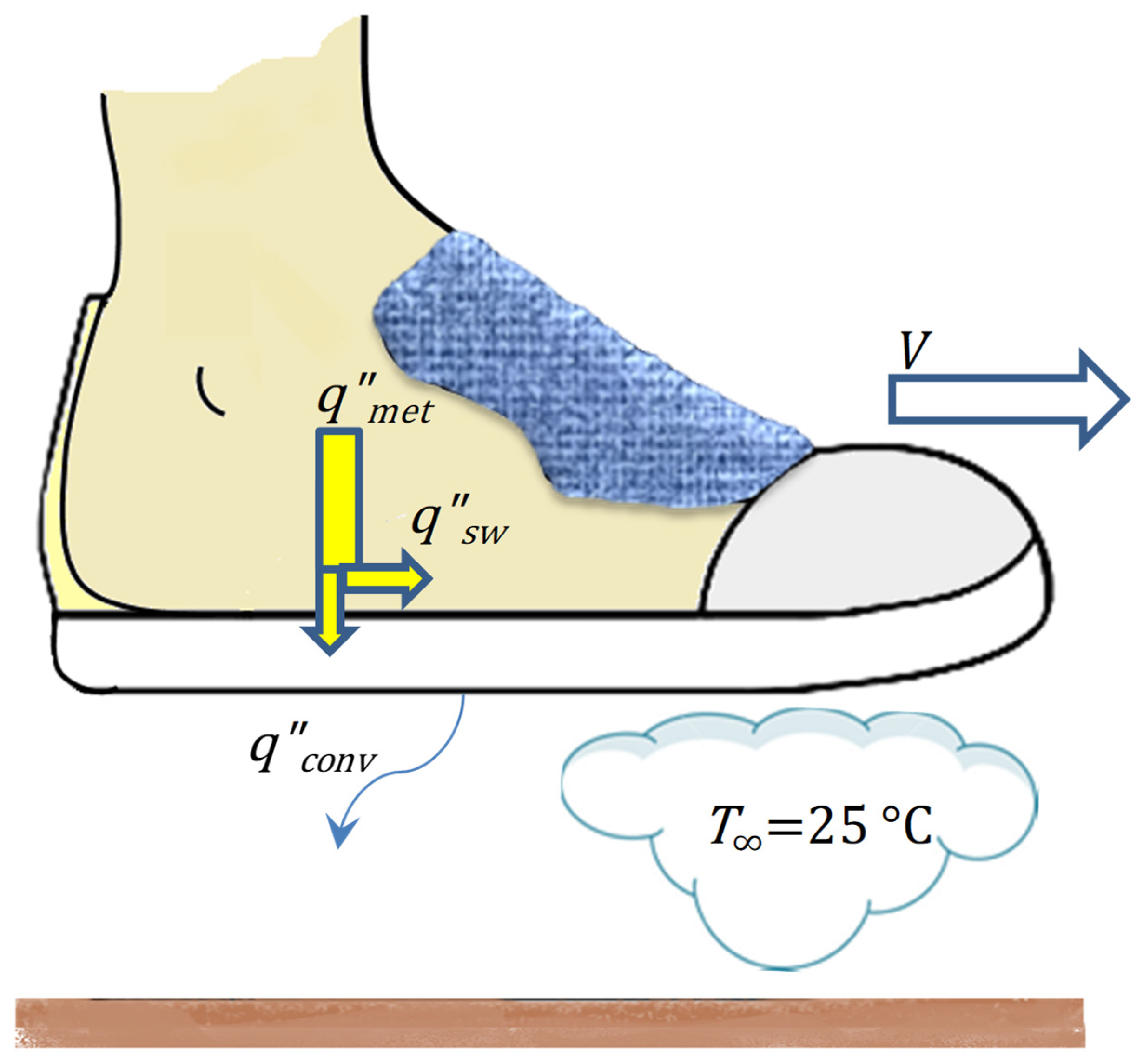
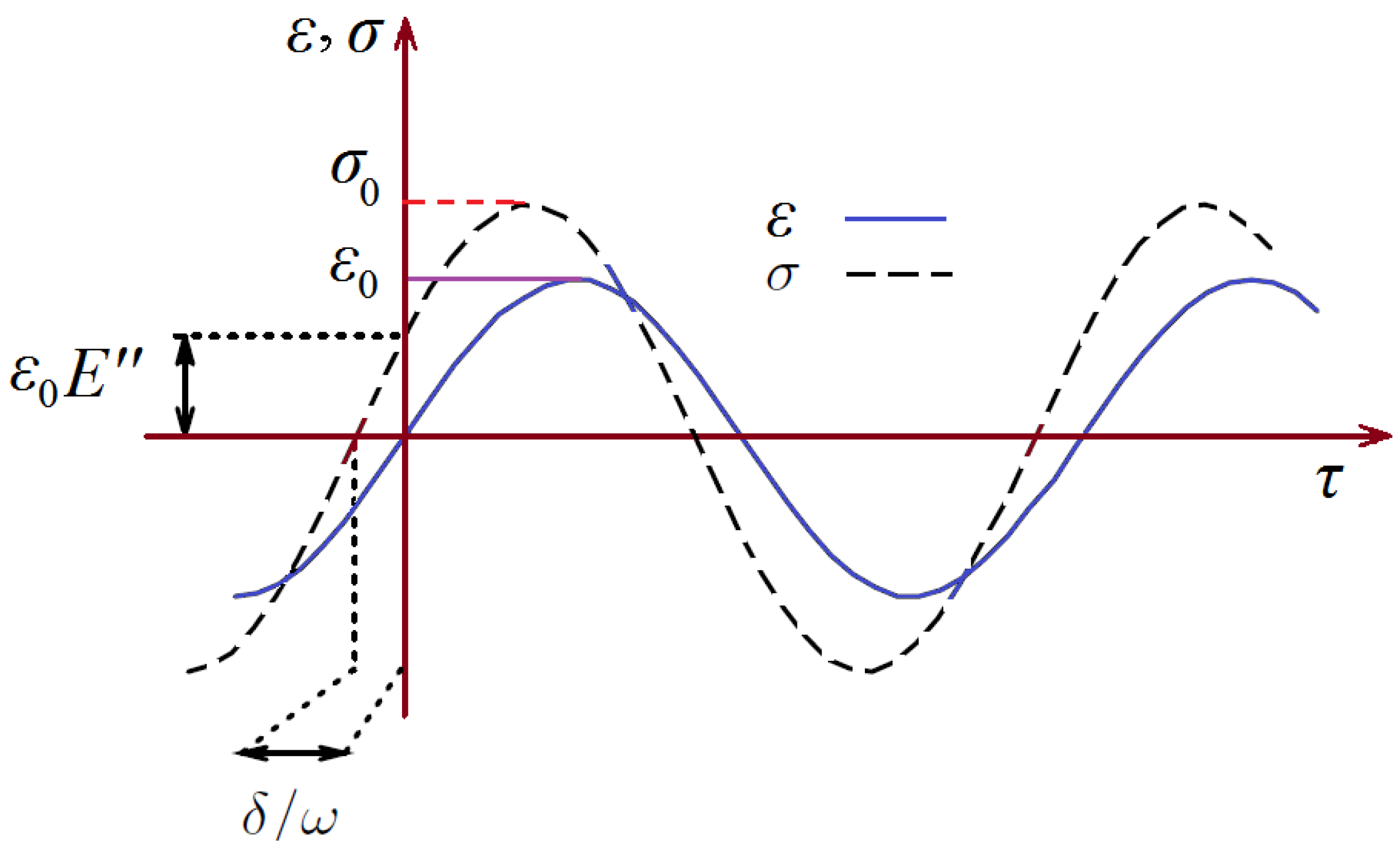

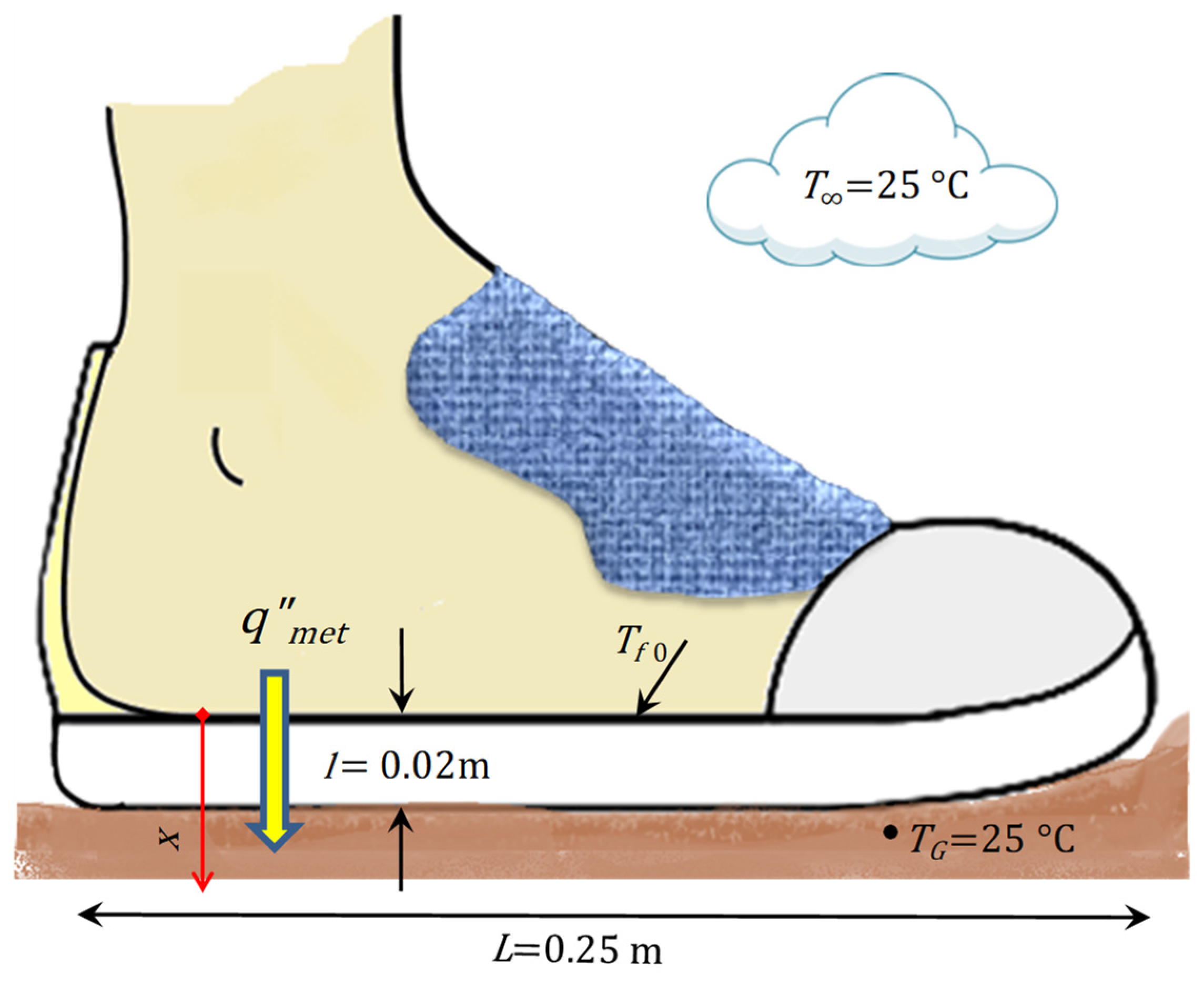
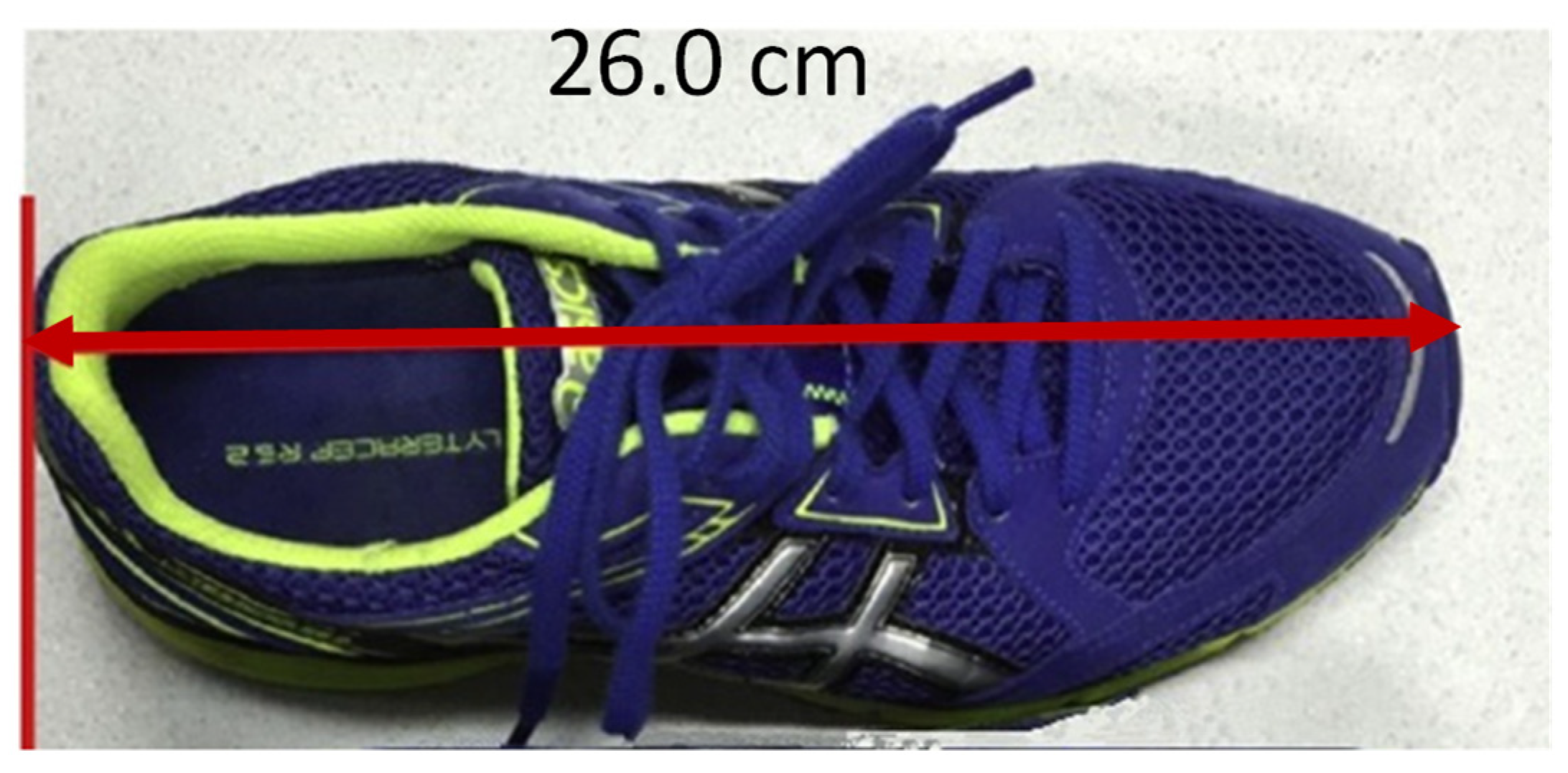

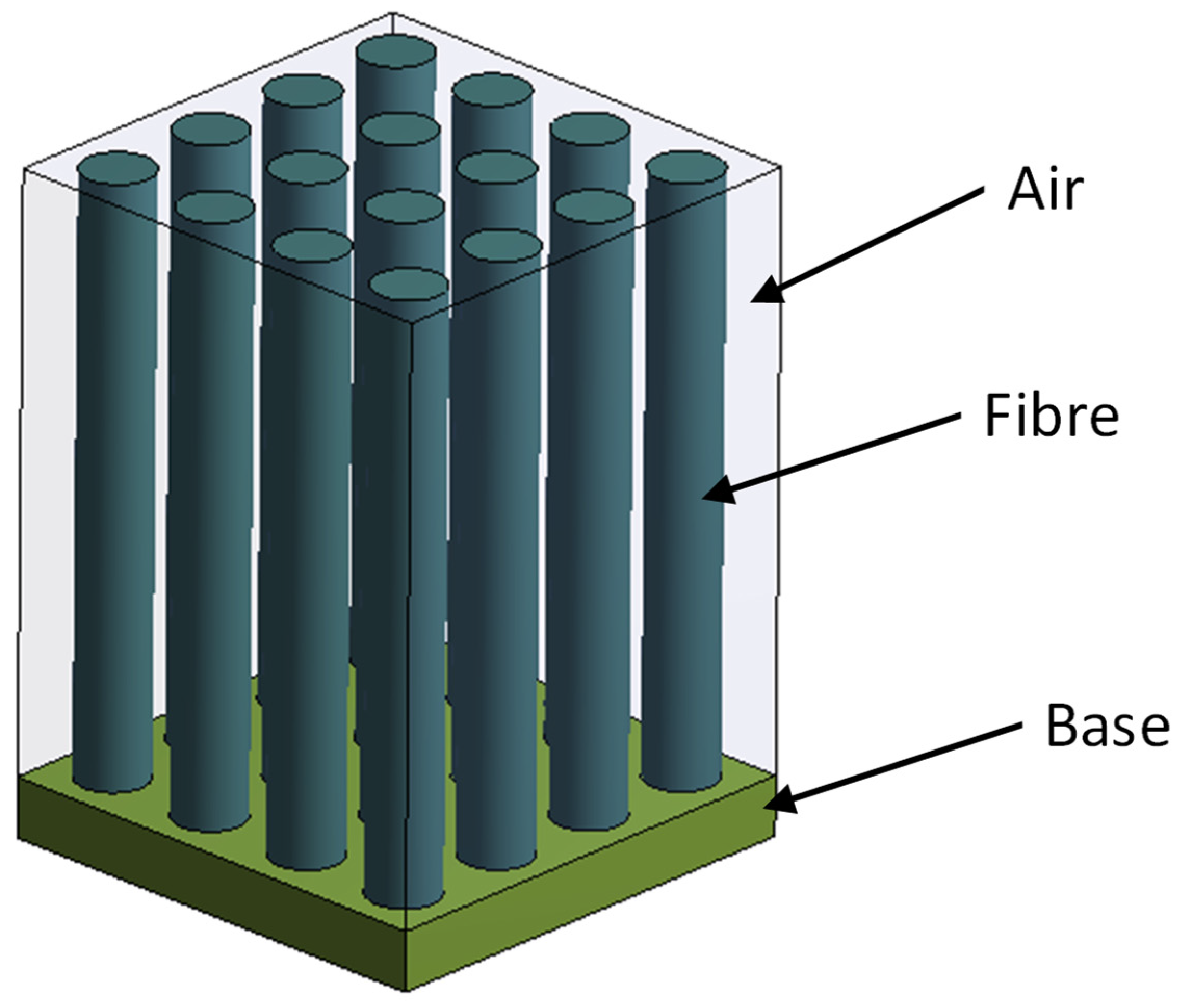

(Pa) | (Pa) | Hardness | |||
|---|---|---|---|---|---|
| 2585 | 0.11 | 240 | A45 |
| Temperature (°C) | ||||
|---|---|---|---|---|
| 25 | 1006.96 | 0.0261 | 1.171 | |
| 35 * | 1007 | 0.0269 | 1.135 | --- |
| Speed (km/h) | 3 | 6 | 9 |
|---|---|---|---|
| Max. Contact force %B.W. | 100 | 110 | 170 |
| 1700 | 0.258 | 1130 |
| Pitch (mm) | |||
|---|---|---|---|
| 1.5 | 1386.7 | 0.145 | 619.6 |
| 2 | 1248.1 | 0.096 | 393.9 |
| 2.5 | 1184.0 | 0.073 | 289.5 |
| 3 | 1149.2 | 0.060 | 232.7 |
Publisher’s Note: MDPI stays neutral with regard to jurisdictional claims in published maps and institutional affiliations. |
© 2022 by the authors. Licensee MDPI, Basel, Switzerland. This article is an open access article distributed under the terms and conditions of the Creative Commons Attribution (CC BY) license (https://creativecommons.org/licenses/by/4.0/).
Share and Cite
Nemati, H.; Naemi, R. An Analytical Model to Predict Foot Sole Temperature: Implications to Insole Design for Physical Activity in Sport and Exercise. Appl. Sci. 2022, 12, 6806. https://doi.org/10.3390/app12136806
Nemati H, Naemi R. An Analytical Model to Predict Foot Sole Temperature: Implications to Insole Design for Physical Activity in Sport and Exercise. Applied Sciences. 2022; 12(13):6806. https://doi.org/10.3390/app12136806
Chicago/Turabian StyleNemati, Hossain, and Roozbeh Naemi. 2022. "An Analytical Model to Predict Foot Sole Temperature: Implications to Insole Design for Physical Activity in Sport and Exercise" Applied Sciences 12, no. 13: 6806. https://doi.org/10.3390/app12136806
APA StyleNemati, H., & Naemi, R. (2022). An Analytical Model to Predict Foot Sole Temperature: Implications to Insole Design for Physical Activity in Sport and Exercise. Applied Sciences, 12(13), 6806. https://doi.org/10.3390/app12136806







